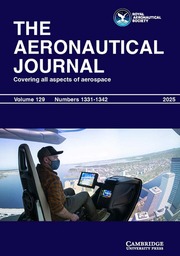Article contents
Hypersonic control flapeffectiveness
Published online by Cambridge University Press: 04 July 2016
Summary
The effects of flap deflection, configuration incidenceand leading edge bluntness on boundary layerseparation and transition have been studiedexperimentally. A quasi two-dimensional flat plateequipped with a full span trailing edge control flaphas been employed for these tests.
The studies have been carried out in a hypersonic guntunnel at M∞ = 8·2 and Re∞/cm= 9·0 × 104. The flap deflection anglesstudied were in the range 0° ≤ β ≤ 30°. Theincidence range was from zero to α = 10° (positive αis nose down). Leading edge bluntness effects weresimulated by the introduction of a hemi-cylindricalleading edge.
The flow structure was studied using high speedSchlieren photography as well as surface pressureand heat transfer measurements. Liquid crystals wereemployed to study the threedimensionality of theflow structure for selected configurations.Analytical theories have been developed to estimatethe flap pressure and heat transfer levels for thesharp and blunt configurations. These are comparedagainst experimental measurements.
Information
- Type
- Research Article
- Information
- Copyright
- Copyright © Royal Aeronautical Society 1996
References
- 7
- Cited by

